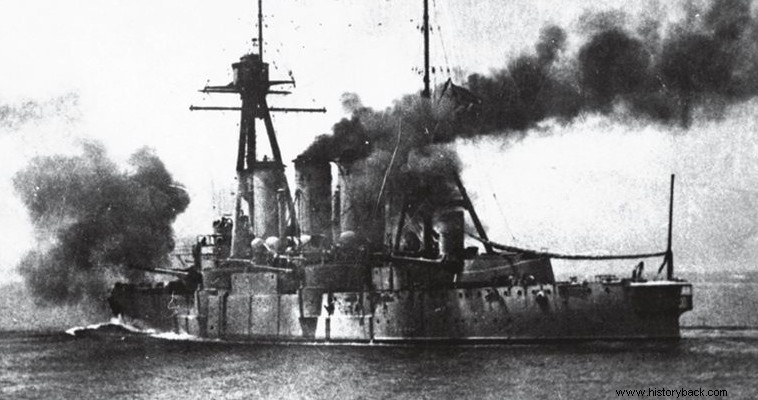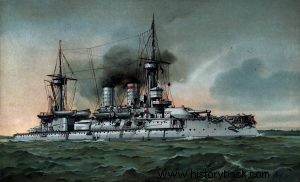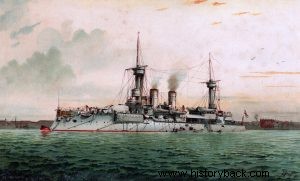
The declaration of the First Balkan War on October 5, 1912, found the Greek Navy reinforced. Opposite him stood the powerful Turkish navy, ready to challenge their supremacy in the Aegean and to help reinforce the fighting divisions of the Turkish Army with Asiatic troops of the Empire. The Turkish fleet commander, Admiral Ramiz, could look to the future with optimism as his fleet was clearly superior to the Greek in displacement and number of guns. The Turkish navy had two powerful German-built battleships, "Barbarossa" (formerly Kurfürst Friedrich Wilhelm) and "Turgut-Reis" (formerly Weissenburg).
These ships were the main opponent of the Greek flagship, the armored cruiser "Georgios Averof". They were launched in 1891 and delivered in 1893 and 1894 respectively. They were the first German open sea battleships. They carried six 208 mm guns. (11in) in three twin towers. However, the guns in the fore and aft turrets had a barrel length of 40 gauge, while those in the central turret had a barrel length of 35 gauge .
The boats also carried 6 105 htl guns. 8 of 88 mm, 12 machine guns and 6 torpedo tubes of 450 mm. They had a displacement of 10,501 tons, a length of 115.7 m, a beam of 19.5 m and a draft of 7.9 m. They had triple expansion engines that produced 10,200 hp and allowed the ships to develop a maximum speed of 16.5 Knots. The boats were well armored. The battleship belt was 12-16in thick. It is no coincidence that the two vessels were considered the most powerful warships in the Eastern Mediterranean.
On the other side, the armored cruiser "Georgios Averof", which was partially built by the donation of the expatriate of the same name, belonged to the "Piza" class. Launched in 1910. The ship carried 4 9.2 inch (234 mm) British Armstrong guns - instead of the Italian 10in, carried by her "sisters" (Pisa &Amalfi) – in two twin turrets, 8 7.5 inch (190 mm) guns in four twin turrets, in the four "corners" of the superstructure, 16 75 mm guns, two 47 mm guns and 3 torpedo tubes of 457 mm. The maximum thickness of the battleship belt reached 8 in (203 mm), while the armor of the battle bridge was 7 in.
The maximum speed of the vessel exceeded 22.5 Knots. This, combined with her reliable British guns, gave the "Averof" a significant advantage over the Turkish vessels, in conjunction with the excellent training of the Greek gunners. The Italian "sister" ships had lighter armor, but higher speed. The Greek navy, however, invested more in protection.
On October 5, 1912, the Greek fleet sailed from Faliro towards Lemnos. The island was liberated the next day and became the main base of the Greek fleet. Lemnos was only a short distance from the exit of the Dardanelles straits. So controlling the straits was easier. In the following period the Greek fleet began to liberate the enslaved islands one after another. From Tenedo, in fact, the Greek captain Pavlos Kountouriotis , eager to engage and defeat the Turkish fleet, did not hesitate to compel the Turkish telegraph operator of the island to send a telegram to the Turkish Minister of Marine, asking him to order the exit of his fleet to the Aegean.
"We have captured Tenedos and are waiting for the opposing fleet. If your fleet doesn't have coal I'm happy to concede. Kountouriotis"! How could the Greek fleet ever have been defeated under such an admiral, who not only defied the enemy, but humiliated him in this way? Hydraios Kountouriotis belonged to that small group of people we are used to calling heroes. He was a Greek with the classic apokotia of the race, this original and original "madness", the Greek philotimos. Kountouriotis was in the right place at the right time.
Elli
It was dawn on December 3, 1912. The Greek ships were patrolling between Imbros and Tenedos. Suddenly the half-asleep Greek crews woke up abruptly. The trumpet of each ship sounded giving the signal for war. Word of mouth spread the happy news. "Columns of smoke from the Dardanelles. The Turks are coming out." A feeling of relief overcame every man of the Greek fleet, from Admiral Kountouriotis to the last sailor. In a production line, the protected cruiser "Menjitier" and three destroyers were sailing towards the exit of the straits. In a little while they had come out and turned south. From the narrows, however, other columns of smoke could now be seen. It was the Turkish battleships that were sailing in turn towards the exit. It was preceded by the flagship "Hairedin Barbarossa", on which Admiral Ramiz Pasha was on board.
Also following in the production line were "Turgut-Reis", and the older "Mesoudie" and "Asar-i-Tefiq". The Turkish battleships initially moved south. But soon they changed course and moved northwest. At 09.00 the two fleets were directly opposite, one from the other, at a distance of 14 km still prohibitive for the execution of fire, with a chance of success. From the bridge of "Averof" Kountouriotis observed the enemy movements. With his cross of Holy Wood hanging around his neck, the admiral addressed his crews with the order of the day. "With the help of God, the wishes of our King, and in the name of justice, I sail with unyielding momentum and with conviction towards victory, against the enemy of the nation. Kountouriotis".
At the same time, the admiral was shouting from the bridge to the sailors of "Averof":"Our time has come, guys. Remember the sailors of '21. We will crush the infidels! God is with us". . Immediately afterwards the admiral came down from the bridge and together with the ship's priest, Archimandrite Daphnos, turned the whole ship around, encouraging his men. The time was 09.22 when two flashes were seen from the fore tower of the "Barbarossa".
The other Turkish battleships followed his example. A few moments later, the Greek ships also responded. On the contrary, the fire of the Greek ships was slower but also more accurate. After an exchange of fire for about 10 minutes, the first fires were visible on the Turkish battleships. The distance that separated the two fleets was constantly decreasing. Kountouriotis from the bridge of "Averof" continued to direct, completely uncovered, the race. In vain his officers begged him to enter the armored bridge and direct the battle from there. He remained undisturbed in his place.
Suddenly Kountouriotis, realizing that the stay of "Averof" in formation did not allow him to make the most of the ship's potential, took the historic decision, which also determined the fate of the conflict. Leaving the command of the squadron of old battleships to the commander of "Spetsai", Captain Ginis, Kountouriotis ordered to raise the famous flag Z on the mast of the flagship. . In this way the admiral declared his intention to move with "Averof" independently.
Barba-George roared as the boilers began to be fed with more and more coal. The "Averof" was now sailing at a speed of 20 knots. The purpose of Kountouriotis was no other than to cross the T of the Turkish fleet with "Averof", while the other three Greek battleships would attack him from the side. At 09.55 "Averof" was located exactly perpendicular to the axis of navigation of the Turkish battleships. His guns were constantly fired at the advancing "Barbarossa," from which jets of fire were constantly shooting up. But the other Turkish ships were also receiving a barrage of fire from the Greek battleships and scouts.
Attacked from all sides, the Turkish admiral realized that if he did not retreat soon into the straits, his fleet would decorate the bottom of the Aegean with the carcasses of ships. He was therefore forced to order a change of course towards the straits. However, his signal, in the thick of the battle, was misinterpreted, as a result of which the Turkish faction lost all cohesion. In the face of the ensuing chaos, the frustrated Ramiz ordered his ships to sail independently towards the straits.
Kountouriotis, seeing the dissolution of the Turkish formation, ordered the attack of the destroyers against the enemy. Unfortunately, however, the radio antenna of "Averof" had been destroyed by enemy fire and, luckily for the Turks, the signal never reached the Greek destroyers. Irritated then, the admiral decided to confront the Turkish fleet alone, with "Averof", the "seitan papor", as the Turks called it. The sight was truly unique. A single ship was chasing an entire fleet by itself! All the Turkish ships and coastal artillery fired incessantly against the "Averof". However, their fire was tragically wrong and the lucky "Barba Giorgos" escaped.
Despite the pursuit of "Averof", however, the Turkish ships managed to enter the straits, even if they were on fire. The naval battle had ended with the complete predominance of the Greek fleet. It had lasted just 63 minutes of the hour. During the "Battle of Helles" the Greek fleet suffered minimal damage. A single man was killed and eight wounded . On the contrary, the Turkish fleet had suffered serious damage and serious losses. More than 100 men had been killed and as many wounded. "Barbarossa" suffered the most serious damage.
Meanwhile the Turkish newspapers, apparently by order of the government, competed with each other in publishing the most obscene monstrosity. This is how some of them assured their readers about the sinking of "Averof" at the entrance of the straits. Still others described in vivid colors the sinking of the "Averof" 70 n.m. from Piraeus, to whose port it was being towed, after the serious damage it had suffered in the naval battle. Finally, they made a reason for a disorderly retreat and the destruction of the entire Greek fleet!
Lake
After their defeat in the Naval Battle of Hellas, the Turks, after quickly repairing their ships with the help of German technicians, decided to go out to the Aegean again. They needed a naval success to restore their prestige. After all, public opinion was upset when, despite the horrible lies of the newspapers, the bitter truth was finally revealed. However, the exit to the Aegean was a difficult undertaking, since the "devil ship" of the Greeks, the legendary "Averof", was sailing in the area. A way had to be found to remove him from the area.
On January 1, 1913, a Turkish warship, painted in the colors of the Imperial Russian Navy , was coming out of the straits unseen, heading for the central Aegean. It was the cruiser "Hamidie". The very next day, the Turkish bait made its presence felt, bombarding Syros. Everyone feared a possible cruiser attack on Piraeus. Kountouriotis, however – fortunately – did not share the government's concerns and proposals. He once again rose to the occasion and decided to remain with the whole fleet in Mudros.
On January 5, 1913, Admiral Ramiz's fleet made its appearance at the exit of the straits. Ramiz was certain that his diversion with Hamidieh had succeeded and that the Greek fleet was scattered in pursuit of the cruiser. On the mast of his flagship, the battleship "Hairedin Barbarossa", fluttered the war flag of the homonymous corsair of the 16th century, which had become the fear and terror of Christians. By using this historic relic, Ramiz hoped to lift the battered morale of his men.
The Turkish fleet was of course noticed by the Greek destroyers "Leon" and "Aspis". At 09.45 the Greek fleet sailed to meet the enemy. A few minutes later the two fleets came into visual contact. The Turkish battleships sailed at the head of the fleet, in a production line with the well-known order, "Barbarossa", "Turgut-Reis" and "Mesoudie". The cruiser "Menjitier" had also joined the line of battleships. At the sight of the enemy, Kountouriotis issued the daily order to his men:"Everything depends on today for our dear Greece. You look like lions. Kountouriotis".
At 11.34 the Turks again opened fire first from a distance of 8,400 meters. A minute later the Greek ships responded. The Turkish fire was as usual heavy and as usual extremely misguided! Instead, the Greek ships responded with well-aimed strikes. At 11.45 the "Barbarossa" was engulfed in flames by 15 consecutive well-aimed shots from the "Averof" against it.
One of the shots struck the ship's mast and severed it, throwing the pirate's flag, with the words of the Koran above, overboard. Another shell hit the ship in the middle turret of the 11-inch guns. The projectile penetrated the tower's armor and destroyed it, killing 33 of its 35 men. After that, the suffering "Barbarossa", turned back. The other boats followed. The Turks were trying to enter the straits again. The "Turgut-Reis", which had remained unscathed until then, entered the "tail" of the Turkish line, as the rear guard of the fleet.
Kountouriotis, for his part, was not satisfied. He wanted to completely destroy the enemy fleet. That's why he started, only with the fastest "Averof", to pursue the Turks again. Despite the new blows inflicted by the "Averof" on the enemy ships, it did not manage to prevent their withdrawal. The old Greek battleships could not follow it and this alone could not defeat an entire fleet. Thus at 14.34 the Turks again entered the safety of the straits, under the protection of coastal artillery. The naval battle was over. The new victory definitively ensured the dominance of the Greek fleet in the Aegean.

The Kurfürst Friedrich Wilhelm.

The Weissenburg.
